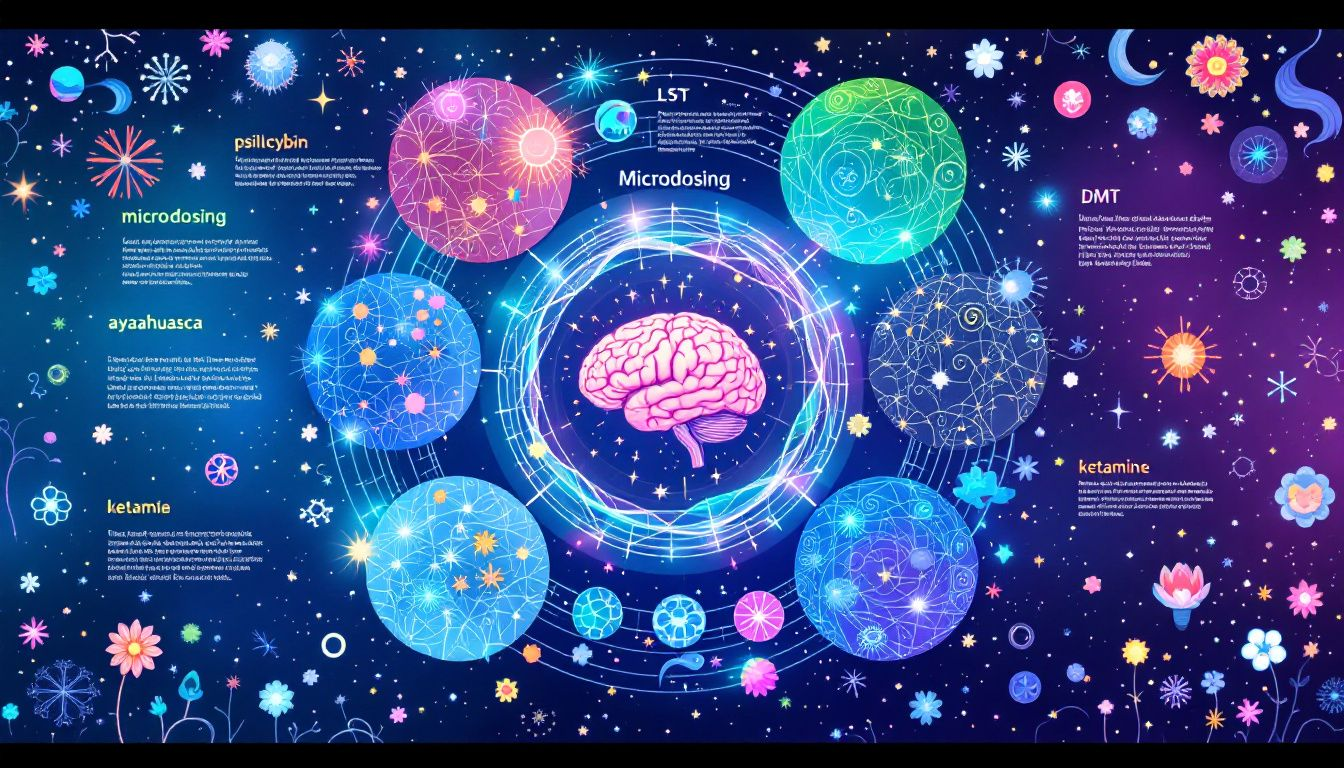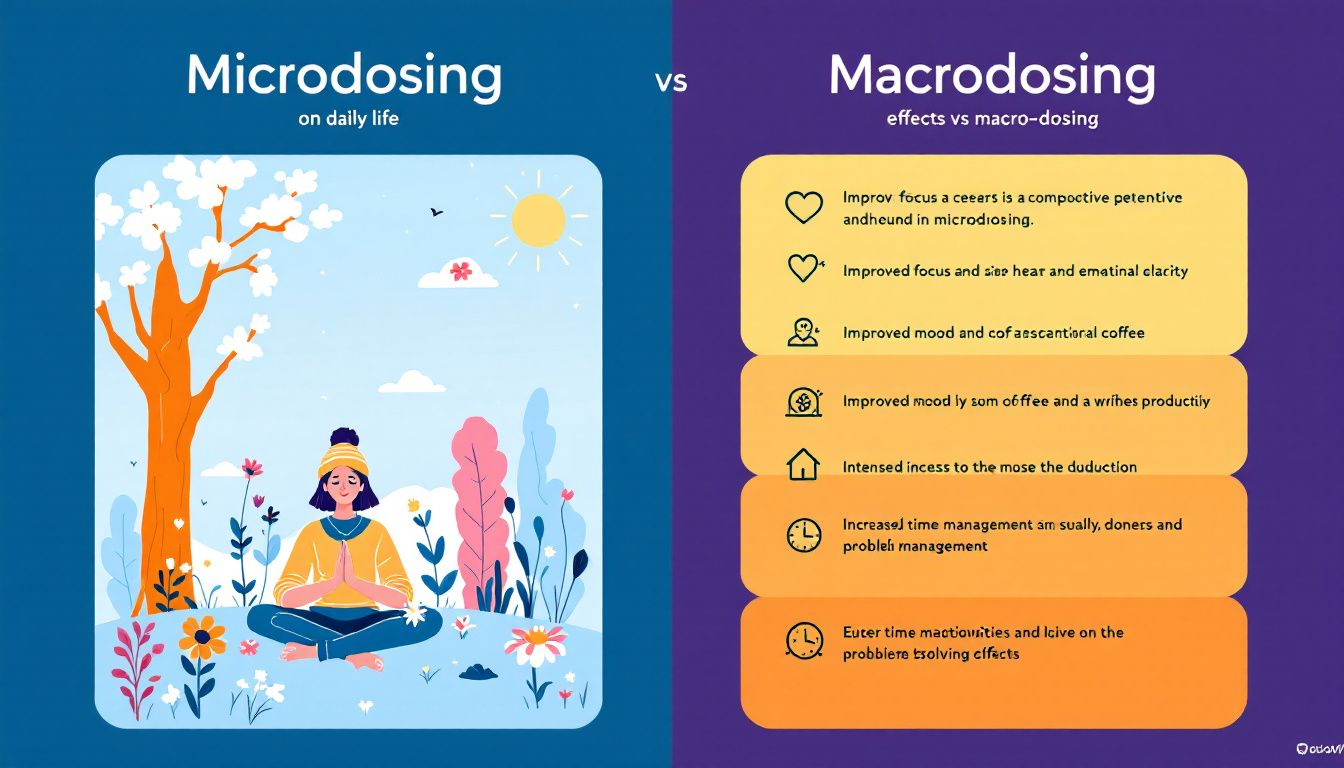How To
Microdosing vs Macrodosing: Finding the Best Approach for Psychedelic Benefits
Microdosing vs macrodosing offer distinct experiences with psychedelics. Microdosing aims for subtle mood and cognitive benefits with small doses, while macrodosing uses larger doses for deep, transformative experiences. This article will help you understand the differences, benefits, and risks of each approach in the context of microdosing vs macrodosing.
Key Takeaways
- Microdosing and macrodosing serve distinct purposes; microdosing aims for subtle mental health enhancements, while macrodosing seeks profound therapeutic transformations.
- Scientific interest in microdosing has surfaced due to potential benefits in mood and cognitive function, though results remain inconsistent and warrant further research.
- Both dosing methods present unique risks; microdosing’s effects may be milder, whereas macrodosing can lead to significant psychological challenges, necessitating careful preparation and consideration.
Defining Microdosing and Macrodosing

Microdosing involves taking very small doses of psychedelic substances, such as LSD or psilocybin, typically between one-tenth to one-twentieth of a full recreational dose. This practice aims to enhance mood and cognitive function without causing significant perceptual changes. For example, a typical dosage for microdosing might range from 10 to 20 micrograms of LSD or about 0.1 to 0.3 grams of dried psilocybin mushrooms.
On the other hand, macrodosing involves taking substantial doses of psychedelics, leading to intense emotional shifts and deep introspection. The dosage for macrodosing LSD, for instance, ranges between 100-200 micrograms.
While microdosing is often used to improve daily functioning and well-being, macrodosing is suitable for significant therapeutic breakthroughs. The goals of these two approaches are fundamentally different. Microdosing seeks incremental improvements in mental and emotional well-being, allowing individuals to maintain normal activities while subtly enhancing their mood and cognitive abilities.
In contrast, macrodosing aims to provoke significant, life-changing experiences, often described as among the most psychologically challenging and transformative moments of one’s life.
The Science Behind Microdosing

Microdosing psychedelics, such as LSD and psilocybin mushrooms, has garnered significant interest in recent years. Scientific studies reveal that microdosing leads to changes in subjective awareness, albeit with inconsistent effectiveness across different individuals. Some benefits are reported in areas of mood enhancement and cognitive function, while other studies show minimal evidence for such effects. This inconsistency calls for more high-quality research to substantiate these findings.
Despite the mixed results, the potential benefits of microdosing are compelling enough to warrant further exploration. Calls for more rigorous scientific research are growing louder, with researchers aiming to explore psychedelic microdosing more comprehensively.
The current state of research highlights the promise of microdosing psychedelics but also underscores the need for more concrete evidence to fully understand its impact on the brain and overall well-being.
Mental Health Benefits
One of the most promising aspects of microdosing is its potential to improve mental health outcomes. Individuals who microdose often report significant improvements in mood, as well as reductions in symptoms related to anxiety and depression. This suggests that microdosing could offer therapeutic effects for those struggling with mental illness, providing a subtler, less disruptive alternative to traditional treatments.
The beneficial effects of microdosing on mental health are increasingly being explored. As more people share their positive experiences, the potential for personal growth and enhanced well-being becomes more apparent. These anecdotal reports, combined with preliminary scientific findings, indicate that microdosing psychedelics could be a valuable tool for improving mental health and overall well-being.
Enhanced Creativity and Focus
Another intriguing benefit of microdosing is its potential to enhance creativity and focus. Research has shown that low doses of LSD can lead to measurable improvements in creative thinking and problem-solving abilities. This suggests that microdosing psychedelics may alter brain pathways involved in creative processing, promoting greater cognitive flexibility and innovative thinking.
In addition to creativity, microdosing also appears to enhance cognitive functions such as focus and attention. This can contribute positively to daily tasks, making it easier to stay on track and complete work efficiently.
Overall, the integration of low doses of psychedelic compounds in practice can promote enhanced creativity and cognitive performance, supporting various personal and professional endeavors.
Therapeutic Effects of Macrodosing
Macrodosing psychedelics is often associated with deep, transformative experiences. These higher doses can induce profound insights and emotional breakthroughs, suitable for significant therapeutic interventions. For instance, a typical macrodose of LSD ranges from 100-200 micrograms, which can lead to intense hallucinogenic experiences and deep introspection.
The therapeutic potential of macrodosing lies in its ability to provoke significant psychological shifts. These experiences can be incredibly challenging, but they often result in long-lasting positive changes in mental health and well-being. Many individuals report that the insights gained from macrodosing have a profound impact on their lives, leading to personal growth and improved mental health outcomes.
Psychological Effects
The psychological effects of macrodosing are both profound and transformative. Users often experience significant alterations in consciousness, which can facilitate long-lasting psychological changes. These experiences are frequently described as among the most intense psychological challenges individuals have ever faced, leading to personal revelations and deep introspection.
Many people report that macrodosing has led to profound personal growth and healing. The intense experiences can help individuals confront and process deep-seated emotional issues, leading to improved mental health and well-being. This makes macrodosing a powerful tool for those seeking significant psychological and emotional breakthroughs.
Clinical Trials and Research
The growing body of clinical research on macrodosing psychedelics highlights its therapeutic potential. Notable studies, particularly on psilocybin, demonstrate its effectiveness in treating various mental health conditions. These studies provide strong evidence supporting the safety and therapeutic effects of macrodosing, making it a promising option for clinical applications.
Despite the promising results, there is a need for more research to fully understand the therapeutic potential of macrodosing. Current clinical trials and scientific studies are laying the groundwork for future research, but more high-quality studies are needed to confirm these findings and expand our knowledge of the benefits and risks associated with macrodosing psychedelics.
Comparing Microdosing and Macrodosing

When comparing microdosing versus macrodosing, it’s essential to understand the distinct goals and outcomes of each approach. Microdosing typically involves administering small amounts of psychedelic substances at regular intervals, aiming for incremental improvements in mental and emotional well-being without significant perceptible effects.
In contrast, macrodosing involves a higher dose that leads to significant alterations in perception, mood, and cognition, often resulting in profound therapeutic breakthroughs. Both approaches offer unique benefits, with microdosing enhancing daily functioning and cognitive abilities, while macrodosing provides deeper, transformative experiences.
Understanding these differences can help individuals choose the approach that best aligns with their personal goals and needs.
Daily Life vs. Transformative Experiences
Microdosing is often seen as a way to enhance day-to-day life without major disruptions. Individuals who microdose can maintain normal functioning, allowing them to integrate the subtle benefits into their daily routines. However, existing studies show mixed results regarding the impact of microdosing on creativity and cognitive function, with some indicating no significant enhancements.
On the other hand, macrodosing is designed to provoke significant, life-changing experiences. These transformative psychedelic experiences can lead to profound personal growth, but they also require careful consideration and preparation. The intense nature of macrodosing means it is not suitable for regular, daily use, but rather for occasional, deeply introspective sessions.
Safety Considerations
Safety is a critical consideration when using psychedelics, whether microdosing or macrodosing. Recent studies highlight potential risks associated with macrodosing, such as hallucinogen persisting perception disorder (HPPD). These risks underscore the importance of proper preparation and guidance when undertaking macrodosing sessions.
Microdosing also carries some risks, although they are typically less severe. Some users report experiencing physical discomfort when microdosing, indicating potential risks associated with regular low-dose intake. As with any substance, it is crucial to approach psychedelic use with caution and awareness of the potential risks and benefits.
Practical Applications and Personal Growth

Psychedelics offer a range of practical applications that can significantly enhance personal growth and well-being. Both microdosing and macrodosing have shown potential in improving mental health outcomes, self-fulfillment, and resilience. While macrodosing is often linked to transformative therapeutic experiences, microdosing provides a more subtle, daily enhancement of mood and cognitive function.
The benefits of psychedelics extend beyond mental health, offering unique opportunities for self-improvement and personal growth. Whether used for therapeutic purposes or personal development, psychedelics can provide valuable insights and facilitate significant positive changes in individuals’ lives.
Pain Management
Psychedelics have also shown promise in pain management, with approximately 49.2% of individuals reporting using microdoses of psychedelic substance for this purpose. Over two-thirds of respondents experience pain relief from psychedelics, often perceiving it as superior to conventional pain medications. Conditions such as cluster headaches, complex regional pain syndrome, and fibromyalgia are frequently reported among those who benefit from psychedelic use, highlighting the role of pain perception in their effectiveness.
However, the benefits of microdosing for pain management are noted to be weaker and may not significantly impact daily functioning. More clinical research is needed to evaluate the efficacy of psychedelics in managing chronic pain conditions. Despite this, the potential analgesic effects of psychedelics continue to be a promising area of exploration.
Addiction Recovery
Microdosing has shown mixed results in addiction recovery, with some studies noting reductions in smoking and substance use. However, current research is insufficient to conclusively support microdosing as an effective treatment for addiction. Some individuals report improvements in mood and reductions in anxiety, which can be beneficial during recovery, but others experience worsened anxiety and memory issues.
Personal stories, such as that of Ayelet Waldman, highlight the potential of microdosing to aid in overcoming depression and mood swings, thereby supporting addiction recovery. While more research is needed, the therapeutic potential of psychedelics in treating mood disorders integral to addiction recovery is an area of significant interest.
Preparing for Your Psychedelic Journey

Proper preparation is essential for a safe and beneficial psychedelic experience, especially at higher doses. Factors such as set (the individual’s mindset) and setting (the physical and social environment) play a crucial role in shaping the experience. Preparation for a macrodose typically takes months, emphasizing the need for a thoughtful and deliberate approach.
Ensuring a beneficial psychedelic experience involves careful planning and guidance. This includes creating a safe, comfortable environment and having support available if needed. Proper preparation can help mitigate risks and enhance the positive outcomes of the psychedelic journey.
Dosage Guidelines
Choosing the right dosage is a critical factor in ensuring a safe and effective psychedelic experience. For microdosing, the dosage typically ranges from one-tenth to one-twentieth of a full dose recreational dose, while macrodosing involves much higher doses. Understanding the appropriate dosage for your needs can help you achieve the desired effects while minimizing risks.
It’s important to start with a low dose and gradually increase it if needed. This approach allows you to gauge your body’s response and adjust accordingly. Keeping a journal of your experiences can also help you track the effects and make informed decisions about dosing.
Integration Practices
Integration practices are crucial for translating the insights gained during a psychedelic experience into actionable changes in everyday life. Creating space for reflection and sharing experiences with empathetic listeners can aid in emotional processing and integration. Engaging with nature post-experience can also facilitate a smoother transition back to daily functioning.
The integration phase is essential for retaining the lessons learned during the psychedelic journey. By reflecting on the experience and incorporating the insights into daily life, individuals can achieve lasting personal growth and improved well-being.
Summary
Exploring the realms of microdosing and macrodosing psychedelics reveals a broad spectrum of benefits and applications. While microdosing offers subtle improvements in daily life, enhancing mood and cognitive functions, macrodosing provides profound, transformative experiences that can lead to significant psychological breakthroughs. Both approaches have their unique advantages and risks, making it essential to choose the method that aligns with your personal goals and needs. Whether you’re looking to enhance your creativity, manage pain, or seek deep emotional healing, psychedelics offer a promising avenue for personal growth and improved mental health outcomes. As we continue to explore and understand these substances, the potential for positive change becomes increasingly apparent.
Frequently Asked Questions
What is the difference between microdosing and macrodosing psychedelics?
Microdosing entails consuming minimal amounts of psychedelics to improve mood and cognitive function without major perceptual alterations, whereas macrodosing involves higher doses that induce profound emotional and psychological experiences aimed at therapeutic breakthroughs. Therefore, the key distinction lies in the dosage and the resulting effects on perception and experience.
What are the mental health benefits of microdosing?
Microdosing can enhance mood and alleviate anxiety and depression symptoms, providing a less disruptive alternative to conventional treatments. This approach may significantly contribute to overall well-being and personal development.
How does macrodosing affect psychological health?
Macrodosing can lead to significant psychological benefits by facilitating deep emotional processing and personal insight, which may enhance overall mental health and well-being. Such profound shifts in consciousness can result in lasting positive changes for individuals.
Are there any risks associated with microdosing and macrodosing?
Both microdosing and macrodosing involve potential risks, including hallucinogen persisting perception disorder (HPPD) from macrodosing and possible physical discomfort from microdosing. To minimize these risks, it is crucial to engage in proper preparation and seek guidance.
How can I prepare for a psychedelic experience?
To prepare for a psychedelic experience, ensure you have a supportive environment and a positive mindset, select an appropriate dosage, and plan for integration afterwards by reflecting on your insights with empathetic listeners. This preparation is essential for maximizing the potential benefits of the experience.
